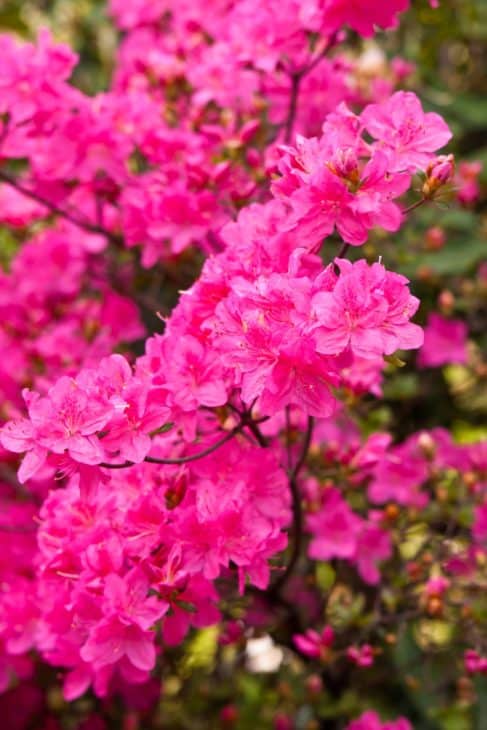Rhododendrons are showy stars in the gardening world. They produce masses of brightly colored flowers, creating a panorama of hues that entice you to spend longer in the garden. When planting rhododendrons, it is essential to consider the toxicity of the plant and the effect it can have on animals and people.
Contents
Rhododendrons are poisonous to people, dogs, cats, horses, livestock, birds, and some insects. Rhododendrons contain grayanotoxin, a richly oxygenated diterpenoid found in all parts of the plant, including the nectar. The poison acts quickly once ingested, and the consequences can be fatal.
When you are planting a garden, it is always wise to consider the animal and human occupants of the garden. If you have babies, toddlers, young kids or pets, it is necessary to choose plants wisely to prevent accidental poisoning.
What Poison Do Rhododendrons Have?
Rhododendrons contain a toxin called grayanotoxin, also known as rhodotoxin, andromedotoxin, or acetylandromedol.
It is found throughout the plant, including the nectar. The highest concentration is in the terminal five to ten leaves on a stem. Researchers believe that as these leaves are the most important for new growth, the plant directs the toxin to this area to ensure its success.
Grayanotoxin affects the intracellular sodium ion channels and muscarinic receptors in the body. Sodium channels are critical for correct nerve and muscle functioning throughout the body. The cardiovascular and respiratory systems are particularly adversely affected.

Are Rhododendrons Toxic To Humans?
Rhododendrons are toxic to humans but rarely fatal. The extent of the symptoms is dependent on the amount of grayanotoxin ingested, making children more susceptible to the effects.
Symptoms include salivation, diarrhea, vomiting, dizziness, a low pulse rate, hypotension, low oxygen levels, visual disturbances, muscle weakness, and fainting. People show evidence of intoxication, struggling to stand or make sense when speaking. In rare cases, atrial fibrillation, myocardial infarction, asystole, and respiratory paralysis may result in a coma followed by death.
Grayanotoxin is a terpenoid and thus results in an unpleasant burning in the mouth when eaten. This sensation usually discourages most people from eating large quantities. In humans, the most common ingestion occurs from rhododendron honey. The symptoms may be seen within a few minutes to several hours after ingesting the poison.
Is Rhododendron Honey Toxic?
Rhododendron honey is made from rhododendron nectar and is sometimes called mad honey.
Rhododendron honey is toxic and causes symptoms similar to those seen if a part of the plant is ingested. Mad honey is found mainly in Turkey and the eastern coast of the Black Sea.
Some people sell mad honey (also marketed as bitter honey) online, claiming health benefits from taking a daily amount. It is purported to treat erectile dysfunction, low libido, hypertension, bowel issues, and gastric pain.
This is a dangerous practice as the concentration of grayanotoxin varies in the honey resulting in variable daily doses. Taking rhododendron honey medicinally causes similar side effects to poisoning. Many people report feeling drunk after taking it. A study showed that chronic use of the honey resulted in:
- Sinus bradycardia syndrome – the sinus node produces the electrical charge too slowly, resulting in a dangerously slowed heart rate.
- A heart block occurs when the heart’s upper chambers cannot send adequate electrical signals to the lower heart chambers.
- Presyncope is dizziness, visual disturbances, weakness, and perspiration that precede fainting.
Rhododendron honey should not be used medicinally as it is toxic and can lead to death.
Historical Accounts Of Mad Honey Use
Xenophon described one accounting of the effects of mad honey in 401 BC. He explained how soldiers ate honey and succumbed to the impact of the toxic honey.
He described that those that had eaten only a little honey appeared intoxicated. Those that had consumed large quantities seemed to go mad. All the soldiers that ate the honey had vomiting, diarrhea, and weakness. The effects lasted for one to four days, depending on the amount ingested.
A Turkish king, Mithridates of Pontus (65 BC), placed toxic honeycombs along the roadside when an invading army from Pompey The Great was advancing on his territory. The soldiers were delighted with their find and ate the honey. Once the effects of the mad honey incapacitated them, Mithridates’ troops arrived to slaughter the invading Roman army.

Are Rhododendrons Poisonous To Dogs And Cats?
The ASPCA lists rhododendrons as toxic to both cats and dogs. The biological mechanism of poisoning is the same as for humans. Symptoms of rhododendron poisoning seen in canines and felines include:
- Vomiting
- Diarrhea
- Excessive salivation
- Weakness
- Loss of appetite
- Weak, slow heart rate
- Low blood pressure
- Coma
- Death
Fortunately, the leaves cause burning in the mouth, discouraging the animal after the first bite.
Even a small amount of plant matter (0.2% of the animal’s body weight) is sufficient to cause fatal toxicity. This means that a 10 kg animal would only need to ingest 20 grams for the poisoning to occur.
What Animals Can Be Poisoned By Rhododendrons?
Horses, cows, sheep, and goats are all vulnerable to poisoning by rhododendrons. Horses are the least likely to eat the plant as the bitter taste is a deterrent. If a horse does eat any part of the rhododendron plant, they are likely to die from colic or heart failure.
Sheep, goats, and cattle more commonly eat rhododendrons with disastrous consequences. Neurological symptoms such as blindness, incoordination, muscle weakness, depression, heart arrhythmias, and hypotension can lead to death.
In pregnant animals that survive the poisoning, the fetus dies and often becomes mummified, which affects the future fertility of the animal.

Are Rhododendrons Toxic To Birds And Bees?
Rhododendrons are toxic to birds, and generally, they are avoided by birds. Birds die rapidly from exposure to grayanotoxin as they have a small body mass that is quickly affected by the ingestion of the toxin.
Kew Gardens conducted a study where they discovered that honeybees (Apis mellifera) died a few hours after exposure to rhododendron nectar. Mining bees showed symptoms of poisoning that affected their behavior, although they did not die.
Buff-tailed bumblebees did not have any effects from consuming rhododendron nectar over thirty days of feeding on it.
This was a surprising finding as it would seem that poisoning pollinators is counterproductive for plants. The current theory is that rhododendrons have developed the toxic adaptation to target preferred bee species as pollinators. Bumblebees feed for longer on flowers and may be better pollinators for rhododendrons.
Although the honeybees in England died from the rhododendron sap, a sub-species of the honeybee in Turkey can collect the feed on the nectar and produce honey without any toxic side effects. This is why rhododendron honey is typically found around Turkey and adjacent areas.
Conclusion
Rhododendrons are highly toxic plants that should not be planted where children, pets, and livestock could ingest the plant. It would be better to replace rhododendrons with plants with similar flowers and features. Rhododendron honey is not safe to take medicinally.







